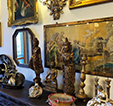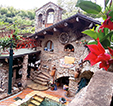
- Address: Casa Museo POESIA di Vittorio Sodo Via Ginevra, 1 Roca di Melendugno (Le) 3343334643
- Contact: vittoriosodo
Partner House of the Association
House Museum POETRY of Vittorio Sodo
Page in preparation
Hotspots


House Museum POETRY of Vittorio Sodo
Page in preparation

Atelier (Milano)
Vincenzo Balena (born in Milan, in 1942) began his career as an artist in the 1960s when the movement known as Existential Realism was in vogue, and initially devoted his attention to the study of animal morphology. From the early 1970s he exhibited regularly at the Montrasio Gallery in Monza and at the Naviglio Gallery in Milan. His work soon attracted the attention of art historians and critics such as Mario De Micheli and Marco Rosci, and later by Rossana Bossaglia, Carlo Pirovano and Lea Vergine. In the early 1980s, when he was influenced by the work of Pier Paolo Pasolini (to whom he dedicated a series of paintings and sculptures), Balena came into contact with such poets and writers as Antonio Porta, Giovanni Raboni and Roberto Sanesi, and with many other writers and art critics in the years that followed. Raboni in particular examined in some depth his later work on the human body: the so-called Disiecta Membra, consisting of body parts fashioned in clay and suspended on wires. This was followed by sculptures in wax, bronze, wood and embossed aluminium, and exhibitions in major venues in Italy (the House of Giorgione in Castelfranco Veneto) and abroad (Düsseldorf, Prague and New York). Balena also worked intensively in the theatre. He produced sculptures and masks for the stage, including for the 1989 play entitled Nel tempo che non è più e non è ancora (“In Times Gone By And Times Still To Come”) at the Teatro del Buratto, with texts by Maurizio Cucchi, the poet who presented him many years later at the 54th International Art Exhibition of the Venice Biennale. Masks have been something of a constant in the work of Balena, and were also the focus of a memorable 2014 exhibition at Villa Badoer in Fratta Polesine (near Rovigo), where a cycle of works dating back to 2005 and 2006 (Antiqua Terra Mater) were set against the backdrop of the grottesche decorations inside the Palladian villa.
His more recent work, with its explicit figurative references, explores the as yet untapped expressive resources to be found in the rejection of technology: that artificial extension of the human mind rescued from an electronics-engendered oblivion. The 2017 exhibition at the Lorenzo Vatalaro Gallery in Milan marks a new turning point in his work, much of which nonetheless is still very true to itself. The artist has painstakingly retrieved manipulated circuits from the earliest computers, generating pages of shorthand and mysterious archaic scriptures, which are presented in a way that elegantly (but slightly disconcertingly) hints at primordial chaos, at obscure origins – and to which the use of backlighting gives a particularly hypnotic power.

Lago di Monte Colombo
Page in preparation

Laboratory house
Gian Franco Morini called ‘il Moro’, sculptor and designer, provocative and paradoxical, exaggerated and contradictory, ingenious and vulgar was born in Faenza in 1955. He attended the Institute for Ceramic Art in Faenza and the Fine Art Academy in Bologna. Augusto Betti and Alfonso Leoni were his teachers, he worked as a young apprentice together with the Masters Panos Tsolakos and Carlo Zauli. Since the Seventies he has worked in the ceramic industry, in international firms, as a researcher.
His ceramics is something of primordial, savage and natural. He likes using dirty, impure and adulterated clays in order to obtain a rough and lumpy result that makes us think about the true earth. In 2016 he transformed his home-workshop, located in the countryside of Faenza, into a Garden of Art, the sculpture of his life:’ Der Kunst Garten' an artistic space in constant metamorphosis. Der Kunst Garten, in German language, to emphasize the international vocation of this garden: a private space in a garden, a lawn and a house without gates or barriers, where anyone can go, stop, have a chat with the landlord, and watch the artworks on exhibit.
Since its opening, the museum has taken on new geometries, the metamorphosis is continuous. Adjacent to his laboratory house, the garden can be visited for free.
Monumental cemetery
In the so called English Cemetery of Porta a Pinti, in Piazza Donatello in Florence, are buried the most varied foreign personalities who, in the eighteenth century, had chosen Florence as the home of their cultural and economic life. The cemetery is part of the UNESCO Heritage, of the ASCE, of the Cultural Route of the European Council and is well protected by the Ministry of Cultural Heritage.
The English Cemetary , owned by the Swiss Reformed Church in Florence, is a place of historical, religious and cultural witness which was born because of a discrimination: at the beginning of the 19th century non-Catholics were not accepted in the cemeteries of the City and the closest place to burial the Protestants in Florence was Livorno. So there was a need for a Cemetary in Florence with the vocation to be multicultural, multinational and multireligious.
The Cemetery was opened by the Reformed Church of Switzerland in Florence in 1827 thanks to the granting of Grand Duke Leopold II of Lorraine. And few years ago, after being closed for about a century, it reopened, hosting only ashes and maintaining its original vocation of welcoming everyone.
The cemetery inside has a library and the video and tape library of Fioretta Mazzei.
The Cemetery, with approximately 1400 tombs of 16 countries, has many English tombs and this is why it is called English. But there are buried people from Switzerland, United States, and from so many other nations. Among the prominent figures here we find: Elizabeth Barrett Browning, English poet and Giovan Pietro Vieusseux, Swiss writer and publisher.
Born outside the walls of the door called Porta à Pinti was later found inside the city after the arch. Poggi restored it for the move of the capital of the Kingdom of Italy to Florence in 1861. All this has made its position of "island" particularly interesting within the new ring road of Florence.
Various cultural events have been held in recent years in order to enhance and make the cemetery a living place of culture.
Monumental cemetery
In the cemetery at the Allori of Via Senese in Florence are buried the most varied foreign personalities who, from 1800 onwards, had chosen Florence as the City of their cultural and economic life. The Cemetery is part of ASCE and is well protected by the Ministry of Cultural Heritage. The Cemetery is, by vocation, multicultural, multinational and multireligious. It is nominally owned by the Revised Swiss Evangelical Church of Florence, although at the time of its birth the other Protestant churches of Florence participated economically in the purchase and took part in the constitution.
For this reason, there are six Evangelical Churches within the Committee that currently manages the Cemetary (Anglican Church, Baptist, Brothers, Lutheran, Valdese, and Reformed Evangelical).
The Cemetary was founded in 1878 after the English Cemetery was closed due to a new provision on the distance of a cemetery from the city. In fact, the English Cemetery, born outside the walls of the door called Porta à Pinti, was later found inside the city after the arch. Poggi restored it for the move of the capital of the Kingdom of Italy to Florence in 1861.
There are about fifty different nationalities including Australians, New Zealanders, Japanese and Eritreans, and some thirty confessions including, in addition to Catholics and naturally Evangelicals, Muslims and Jews; this is a significant cultural and religious openness, even as a response to an act of discrimination: in 1800 non-Catholics were not accepted in the cemeteries of the city. Today, the Graveyard at The Allori welcomes believers of every religious confession together with non-believers.
Among them is ORIANA FALLACI, a famous writer and reporter; the Swiss painter ARNOLD BOECKLIN, author of the painting the Isle of the Dead; HAROLD ACTON, BRITISH TRADER; THE FAMILY OF PATRIOTA UNGHERESE KOSSUTH; LEONARDO SALAVIOLI, ARCHITETTO ITALIANO; FREDERIK STIBBERT, COLLEGEER OF BRITISH ART; HINKLER, AUSTRALIAN PILOT; ROBERTO LONGHI, HISTORICAL OF ART.
Various cultural events have been held in the last years in order to enhance the Cemetary and give to this place a culturally vitality, considering the buried personalities and the artistic and architectural beauty of the place. A successful initiative was the presentation of the book "In Loving Memory" by prof. Grazia Gobbi Sica, professor of the Florentine University at the Faculty of Architecture and New York University Villa La Pietra, editor Olschky, promoted by the president of the Cultural Circle Piero Gobetti prof. Adalberto Scarlino.